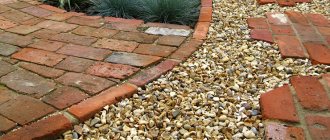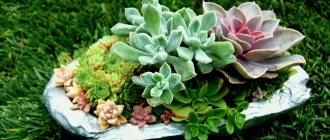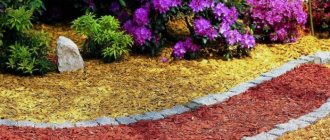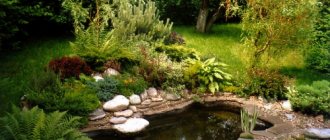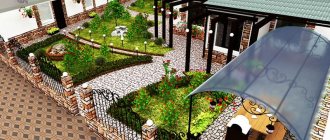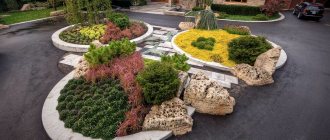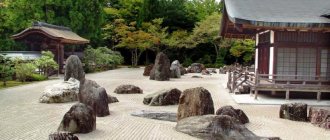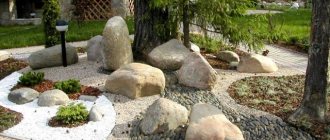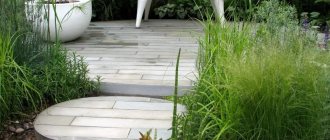Material rating
20 out of 5 Price
16 out of 5
Practicality
20 out of 5
Appearance
20 out of 5
Ease of manufacture
20 out of 5
Labor intensity when using
20 out of 5
Environmental friendliness
final grade
4.8
4.8 out of 5
Natural materials in the interior of country houses and apartments are quite popular, and designers take this into account. Stones, seashells and pebbles are actively used in modern interiors.
Pebbles are rock fragments that have been smoothed by water. Its diameter can be from 1 to 15 cm. Depending on this, pebbles can be small (up to 1.5 cm), medium (up to 5 cm) and large (up to 15 cm). It can be used in construction and for decorative purposes.
Pebbles in the interior
Decorating with pebbles has always been very popular. It can be used not only in interiors with a marine style. Pebbles will fit well in the kitchen (work area), bathroom (floor, walls or pebble rug) and other rooms (wall inserts, arches, columns). Successful use of this material will “revive” the interior and make it “natural”.
Ideas for using pebbles:
- Side podium made of pebbles.
- Finishing the inside of a semi-column or arch.
- Pebble baseboard in the bathroom.
- Pebble floor in the bathroom.
- Kitchen apron (work area).
- Mosaic or panel.
- Pebbles for creating paths.
Photo examples of using pebbles
Pebbles in design and interior No. 1
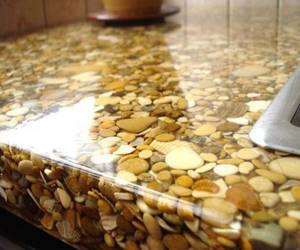
Pebbles in design and interior No. 2
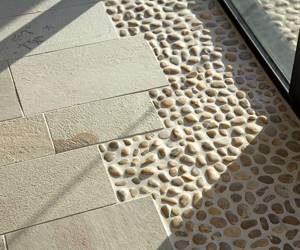
Pebbles in design and interior No. 3
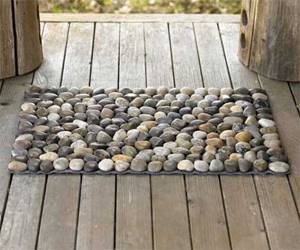
Pebbles in design and interior No. 4

Pebbles in design and interior No. 5
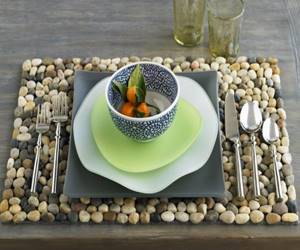
Pebbles in design and interior No. 6
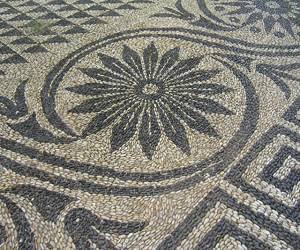
Pebbles in design and interior No. 7

Pebbles in design and interior No. 8
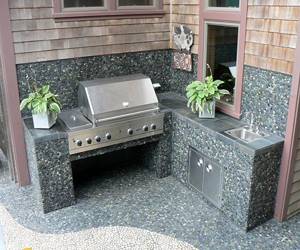
Pebbles in design and interior No. 9
For aquarium
The main decoration of the aquarium is not only the fish, but also the bottom itself. Most often, sea or river pebbles are used for its arrangement. You can buy it in a store or collect it yourself on the sea coast.
In the first case, the soil has already been processed and is ready to be placed in the aquarium. In the second case, the pebbles will need to be washed and treated with boiling water. Large stones will look beautiful; aquarium equipment can be hidden under them.
Mosaic
Pebble mosaics can differ not only in appearance, but also in installation.
The most popular design solutions are:
- Mosaic on a grid is the simplest option. Can take any form. Sold ready-made with carefully selected pebbles. You just need to fix it in the right place. Can be used on walls, floors and wells.
- Mosaic tiles. It consists of pebbles, cement mortar and reinforcing mesh. Fixes like regular ceramic tiles.
- Self-made mosaic. To make a mosaic with your own hands, you will need to carefully select pebbles according to size and shades, come up with a pattern and lay it out yourself. Most often this option is used on garden paths.
According to experts, a mosaic made of natural pebbles will not only decorate the interior, but is also a good natural massager for the feet. To fix a pebble mosaic pattern, you will need a special tile adhesive or a mixture of PVA glue and cement mortar.
The following video will tell you how to properly glue pebbles to the wall when creating a mosaic with your own hands:
Varieties of “landscape” pebbles
Decorative pebbles for the garden are classified according to several parameters:
- By origin. There are river pebbles formed under the influence of currents. Sea and lake pebbles acquire a rounded shape due to the forward movement of waves during high and low tides. Natural minerals and rock fragments, cut into squares of a given shape in the plant, are rolled in industrial drums. The artificial tumbling technique makes it possible to impart a given degree of roundness to a mineral and produce a large batch of stone, the extraction of which in nature is impractical.
- According to mineral composition. The stones can consist of sandstone, limestone, quartzite, marble, which determine the shade of the material.
- By color. The most common shades are dark and light gray, white, and pink. You can expand the color palette using acrylic paint and primer, which protects the coating from external factors.
- To size. Pebbles are pellets with a fraction of 10 to 160 mm. Large pebbles are also called pebbles; smaller material is classified as stone chips.
Pebbles in landscape design
It is natural to want to decorate the landscape design of a dacha or country house in an unusual way, and at the same time preserve its naturalness. Sea or river pebbles will be a good decoration for the landscape. It can be used as a covering for the soil, creating a path, cladding a house and other structures.
garden path
A path in a country house made of pebbles is quite a popular option for using this natural material. Here you can give free rein to your imagination, since the colors, patterns and sizes of pebbles can be very diverse. The only condition when laying is to fix the pebbles on the cement mortar with the edge up. This option will look more aesthetically pleasing and will last longer than conventional embankment paths.
garden flower bed
Landscaping a flower bed using decorative pebbles is a simple and effective way. To make it you will need large sea or river pebbles. Flowerbeds can be of different shapes, as well as with zoning elements.
If the fence is made of a different material, then you can fill the middle with pebbles, leaving limited space for flowers. This option will not only look beautiful, but will also not leave room for weeds.
For the bath
Bath stones must be resistant to sudden temperature changes and have high heat transfer. Volcanic rocks have these properties. Pebbles can be used as the first layer in a sauna heater. This option is the simplest and least expensive. Stones need to be chosen flat in shape and large in size. A red tint indicates the presence of iron, which is not desirable for use.
Pebbles can also serve for decorative purposes: decorating walls, stoves and floors.
For a well
If there is no water supply on the site, a well can become a source of water. The difficulty is not only the digging process, but also the regular maintenance of water purity. For this you need a bottom filter. The ideal option would be river pebbles, which are laid out in three layers on the bottom. Each layer should be 15-20 cm high and have different pebble sizes.
The direct filter consists of a layer of large pebbles, a layer of medium and at the end of small pebbles. The reverse type of filter has the reverse sequence of layers.
Types of pebbles for design
To begin with, it’s worth familiarizing yourself in more detail with the definition of pebbles and its varieties. This is a natural stone, with a rounded surface, bulges and depressions. Typically the natural material considered is flattened, round or oval in shape. The stones are small in size - from 2 to 10 cm in length. The color of natural specimens can be gray, white, brown, black, etc.
Important! Do not confuse pebbles and crushed stone.
The second is also a stone, but it is obtained as a result of crushing rocks, therefore it has sharp edges and chips, and is used in construction. Natural pebbles are formed under the influence of water and wind. An artificial imitation is created through mechanical processing - hard rocks (marble, granite, etc.) are crushed, and then polished, ground and painted in the required color.
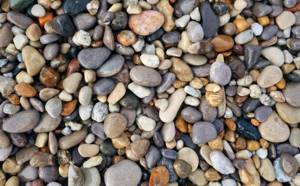
They differ from each other in size, color palette, place of extraction, and other characteristics that determine their scope of application. Types of pebbles:
- Marble - formed from the remains after the formation of solid pieces of rock. Designed for landscape design.
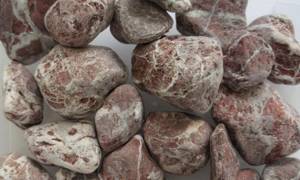
- White — mined near mountain reservoirs. Suitable for laying garden paths, decorating fountains, artificial lakes or streams, as well as shop windows.
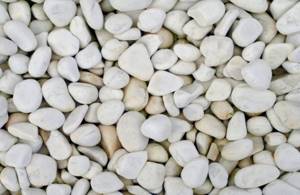
- Gray - small stones with a glossy surface. Mainly used for finishing the walls of functional objects (baths, saunas, bathrooms).
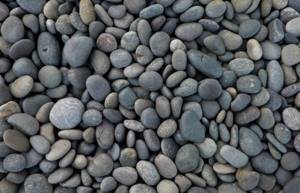
- Black — made from marble and dolomite, can be polished and can be coated with a glossy composition. It is highly resistant to temperature changes and other external factors, and is universal in use.

- Marine - mined on the coasts of salt water bodies. Suitable for decorating various decorative elements in garden areas, zoning walls, laying out floor patterns.
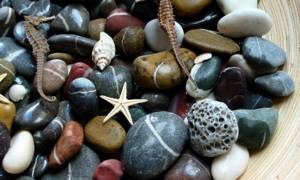
- River - a natural material formed by water and wind from quartz and granite. It can be black, grey, white or tri-color, and is universal in use.
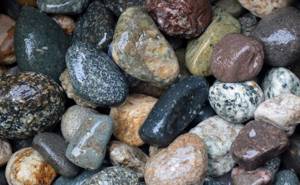
- Caspian - mined on the coast of the Caspian Sea. It is created under the influence of natural factors from sedimentary rocks. Widely used in landscape design as a decorative element.
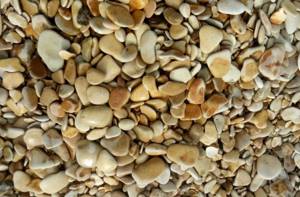
- Black Sea - predominantly gray in color, round in shape. Source: Black Sea coastline. The use in the landscape is quite wide.
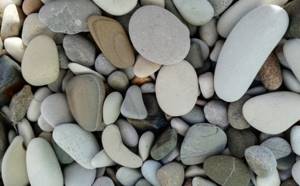
- Granite — made from the remains of granite. It has very high strength and resistance to various environmental factors. Suitable for external and internal work.
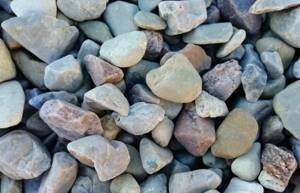
- Silicon — created on the basis of flint. They are mainly used for laying walls and bottoms in artificial reservoirs, since the rock has disinfecting properties and absorbs chemical compounds well.

- Glass — from the name it is clear that glass is used to produce these pebbles. After special processing, the stones are painted in the required color. They are used to decorate bathtubs, bathrooms, mirrors, as well as create various decorative elements to decorate the landscape.
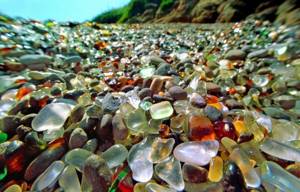
- Washed - this type is obtained after special processing, which involves removing impurities. These pebbles are very easy to use and lend themselves well to gluing.
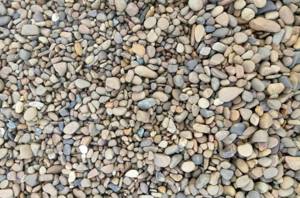
- Colored - another artificial variety, painted with a special composition that provides it with strength and protection from fading. Great for outdoor use.
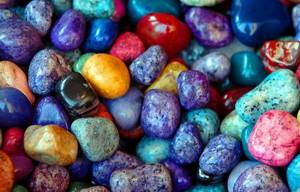
- Decorative - from gypsum, slate, granite and marble waste. The material can be given any shape, size and color. Designed for interior and exterior decoration.
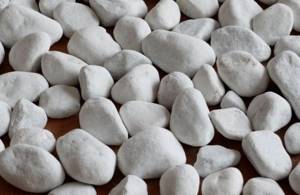
DIY pebble rug
To make your own pebble rug, you will need the following materials:
- Pebbles;
- Glue;
- The base of the mat is made of rubber.
Stage 1. Prepare the rubber base: cut to the required size, wash and dry.
Stage 2. Place the pebbles on the mat in the desired pattern and begin gluing them. It is better to use glue with a transparent structure. The distance between pebbles should be minimal.
Stage 3. The glued pebbles must dry completely.
This rug is good to use in the bathroom. It will not only give the room a nautical style, but will also be a good foot massager.
The master class will tell you how to make a massage mat for the bathroom from pebbles with your own hands:
Decorating ponds with pebbles
Any artificial reservoir needs to be decorated - this gives it naturalness and maximum combination with the landscape. Pebbles, like no other material, are suitable for decorating artificial reservoirs. By combining it with natural stone of a different type and size, you can achieve unique results.
DIY pebble floor
A bathroom floor laid with natural pebbles has a number of advantages:
- Easy installation;
- Individual result;
- Aesthetic appearance;
- Therapeutic effect.
The floor will require pebbles and a cement mixture as a base. First of all, it is necessary to dismantle the old covering and thoroughly clean the floor. The pebbles should be washed well and dried.
The cement mixture is prepared in parts according to the instructions. The base is poured and pebbles are immediately laid out on it. It can be laid out randomly or in the form of patterns. The pebbles should fit tightly together and be approximately the same size. Using this principle, the entire floor is covered.
The pebbles should be immersed in the solution more than halfway. Otherwise, the cleaning process will become more complicated, since some of the debris will fall under the surface of the stone. The best option would be to equip it with a “warm floor” system.
The video shows the features of paving floors using pebbles:
DIY garden path
To independently produce such an element of landscape design you will need:
- Shovel and rake;
- Rubber hammer;
- Level;
- Sand and cement;
- Brush;
- Crushed stone and pebbles;
- Tarpaulin and geotextiles.
First of all, it is necessary to dig trenches 30-40 cm deep. Sand and then crushed stone are poured into it in a 10 cm layer. Curbs are installed using a building level. The space between the curb and the trench wall is filled with concrete. Allow the concrete to harden.
In the place where the pebbles will be laid out, a depression up to 15 cm deep is dug. Crushed stone or stone chips are placed at the bottom and covered with several layers of geotextile or roofing felt. It will protect the path from vegetation growing in it. Next, a mixture of sand and cement (3/1) is poured 5 cm thick and moistened with water.
The pebbles are laid out on the loose concrete mixture and compacted with a rubber hammer. Up to 2/3 of the pebbles are filled with concrete mixture and covered with polyethylene for two days. After this, if necessary, the mixture is added, and after it dries, the surface is cleaned with a brush.
Photos of paths made of colored pebbles in landscape design
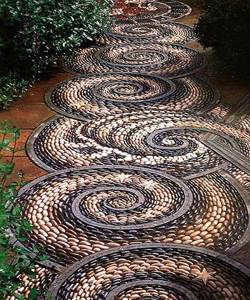
Pebble path No. 1
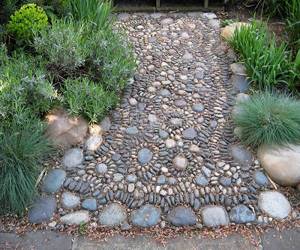
Pebble path No. 2
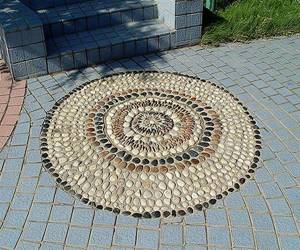
Pebble path No. 3
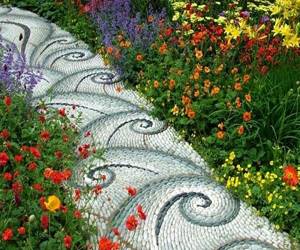
Pebble path No. 4

Pebble path No. 5
Create a themed garden using pebbles
Do you love the sea coast and would like to plunge into the appropriate atmosphere? Create a themed garden in your local area. In such a place you will have the opportunity to relax after depressing everyday life and gain mental strength. To create a cozy corner, you will need appropriate materials, in particular pebbles.
Advice ! To create a themed garden, you will initially have to take your favorite image as a basis, then think about how to implement it.
You can create objects on different themes from pebbles:
- "Sea". An integral object of such a garden is a pond. Pebbles will be used to frame its banks. You can make a lighthouse or a fence from small stones. The last structure needs to be covered with a fishing net. To fully reveal the theme, you can use all the elements related to the sea: a lifebuoy, a hammock made of striped fabric.
- "Tea ceremony". This theme is suitable for lovers of oriental style. It is necessary to place compositions made from pebbles throughout the garden. The main thing is that they are decorated in Japanese style. Pebbles go well with large stones and slabs.
- "Archeology". To create the atmosphere of ancient times, the area can be filled with pebbles or gravel, and several ornamental plants can be placed among them. You can dig the remains of clay or ceramic dishes into the stones, place a bowl, decorate with pieces of tiles or mirrors. The decoration of the composition will be a jug laid on its side. You can plant flowers near its neck. You need to make it look like they are “flowing” out of the container. In spring, such a composition will become a bright spot in the garden.

